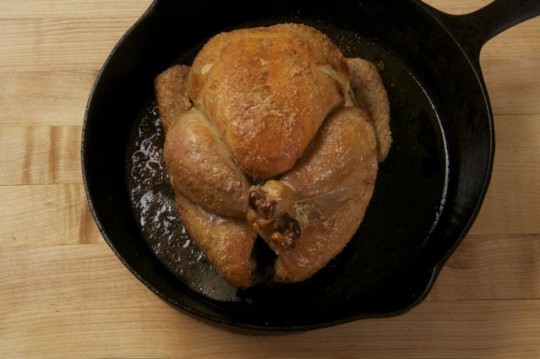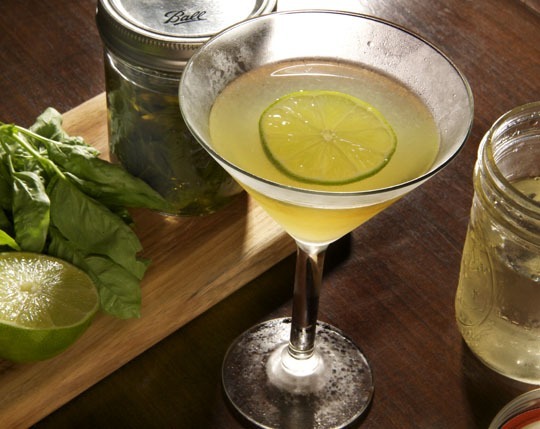Michael Ruhlman's Blog, page 37
August 29, 2013
Bacteria! RUN AWAY! RUN AWAY!

“We all need to calm the fuck down!”/Quote, illustrations, and photo by Alton Brown
The NPR blog Salt started a small #chickenshitstorm Monday when Maria Godoy wrote about a Drexel University study and campaign (a campaign!) to end the dangerous practice of washing chicken in your sink at home. The story was picked up by Slate editor L.V. Anderson and spread from there. Reaching many, including television star and renowned post-it artist, Alton Brown, whose 5-post-it editorial sums up the feelings of many cooks and chefs. When I wrote to him asking to use the image here, he added a header to the email: “We all need to calm the fuck down!”
I love that about Alton.
He’s right. And he’s right to shout. This shit is getting out of hand. Why are so many people so fucking afraid of their food? Wash your chicken or don’t wash it. I don’t care. If you’re going to have sex during the roasting I would ask you to wash your hands. Other than that, your super hot oven will kill any bugs thriving on the bird (but bits of liver, glands, and bone fragments will remain; and who knows if the processor, Julia-like, dropped the bird on the processing floor and called the five-second rule—a little grit never hurt anyone, but I don’t want to eat it).
Do I wash my chicken before roasting? Usually, unless I’m in a rush. If there are fragments and stuff and viscera that I prefer not to put in my roasting pan, of course I rinse it off. I dry it. I truss it. I salt it. Then I put it in a really hot oven. Then I hope to get lucky. But I usually don’t (school night, kids).
I don’t put on an orange suit and cover the kitchen in antibacterial foam. And I don’t blow up my house, just to be sure.
What Alton is saying, and I’ll put it in my words this time, what a lot of us are saying is, “Stop being such a pussy about bacteria.” We all know they can be harmful, sometimes deadly. But I’d really like to know what the odds are for healthy people to get even a tummy ache eating food that hasn’t been processed in a plant that they cook themselves. If you’re too busy to wash your own lettuce and buy the “pre-washed” packaged stuff, that’s probably more of a risk than rinsing a chicken in your sink.
A while back the venerable Harold McGee took me to task in the NYTimes for leaving stock out on a stove “all week” because of the possibility of heat-resistant toxins growing in it. The article implied, wrongly, that I suggested it was fine to leave stock out on the stove top all week (this is the post he refers to). I don’t. (In the winter, I do do this, though I bring it daily to a simmer to kill any bacteria; summer weather is too hot and the stock sours quickly.) Just to see what would happen, I tried leaving stock out on the stovetop without simmering it, as the article had implied was my recommendation. After a day it smelled off. After two days, so bad I’d never have eaten it. After three, the smell actually made me gag. I would respond that there is indeed no danger in leaving stock on the stove top without simmering it for three days, because no one would be able to get near it, let alone eat it.
I don’t think McGee or Jennifer Quinlan, of Drexler University, are wrong. But they throw gasoline on the fire of our fears without putting the facts in context. Can you get food poisoning? Of course you can. What they don’t say is how likely you are. And that’s because there are too many variables. And every possibility, remote or likely, is a 100% possibility to a scientist.
Am I afraid of my chicken? No. Are you afraid of my chicken? Not this one, I hope. From Tea Hill Farms, washed, dried, and trussed, on the day the aforementioned articles appeared.

A rinsed chicken should be properly salted/photos by Donna Turner Ruhlman
Please, buy good food, cook it yourself, use whatever intelligence happens to be available in that tiny head of yours. Then open a bottle of wine and eat dinner with your friends and family.
God, this shit pisses me off.

Salting means all of the bird, and plenty of it. “Let it rain,” says Thomas Keller, on salting.
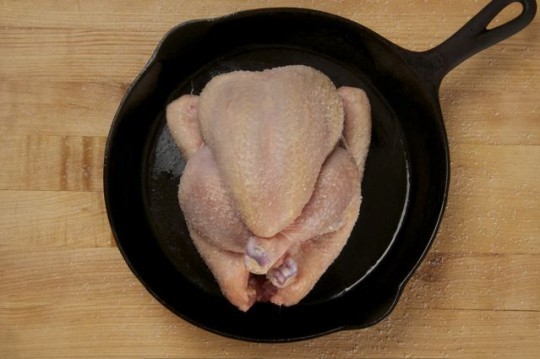
I roast the bird in a cast iron pan at 450˚F for an hour.
Let the bird FINISH COOKING for AT LEAST 15 minutes out of the oven. (It will stay hot for 45 minutes.)
If you liked this post, take a look at these links:
My recent rants Cook Your Own Food. Eat What You Want and America Has a Serious Eating Disorder.
Still in the mood to eat chicken? Then try my recipe for fried chicken.
Julia Child’s roast chicken recipe.
Watch Chef Brian Polcyn truss a chicken.
© 2013 Michael Ruhlman. Photo © 2013 Donna Turner Ruhlman. All rights reserved.
August 27, 2013
Le Creuset Technique: Béchamel Sauce &the Croque Madame
Back again with another technique and recipe—here the classic béchamel sauce, one of the great, yet rarely used, sauces for the home kitchen. We don’t always have veal stock around for classical demi or Espagnole, or often any stock for a velouté. But milk we do have: flavor it with some shallot, a little nutmeg, salt and pepper, thicken it with cooked flour and you have a dynamite all-purpose sauce, for chicken, fish, or my favorite sandwich on earth, the croque madame. So, so good. This is a great weekend lunch or anytime dinner. (FYI, I love the montage that opens these videos but if you’ve seen it, the technique begins at 1:11.)
I asked to use this particular Le Creuset vessel because of its clever utility. In restaurant kitchens, sauté pans regularly double as pot lids. Someone in the LC design shop realized this and actually made an excellent sauté pan that doubles as a fitted lid for a great enameled cast iron pot. It’s already made its way to our teensy kitchen in NYC and will be in regular use there.
I repeat, this is a killer sandwich, and I’m sorry my final evaluation of it was edited out, LC being a family-friendly site and all.
Here’s a link to my LC techniques archive, and this link will take you to LC’s experimental potluck offer.
And please give the béchamel its due. It’s fabulous. Add cream for a simple cream sauce. Add grated cheese for a cheese sauce (easiest and best mac and cheese there is; stay away from Kraft chemical packets, they aren’t necessary). Pour it over sautéed shrimp shells, simmer and strain for a shellfish sauce. Pour it over sautéed mushrooms, add 1/4 cup cream, and you have the best cream of mushroom soup you’ve ever had (add a wee pinch of curry and a few drops of white wine vinegar to season). Seriously, milk is the great all-purpose home sauce starter.
Croque Madame
For the Sauce
1 shallot, minced
2 ounces salted butter
3 tablespoons flour
2 cups milk
Gratings of nutmeg
Salt as needed
For the Sandwiches
4 slices bread, buttered
Dijon to taste
6 ounces sliced ham, warmed or room temperature
2 ounces grated Gruyère
1 ounce vegetable oil
2 eggs
Make the sauce: combine the shallot and butter in a saucepan over medium heat and cook until butter is bubbling and the shallot is translucent. Add the floor and stir to heat the flour and coat it all with butter. (If using unsalted butter, and a pinch of salt here.)
Turn the heat to high and add the milk, whisking continuously until the milk comes to a simmer and thickens. Reduce the heat to medium-low and cook, skimming any skin that may form on the surface, for about 15 minutes and up to 45, then remove from the heat and cover. This can sit like this for up to 4 hours.
Preheat the oven to broil.
Put the pan over medium heat.
Make the sandwiches by spreading each of the first pieces of bread with Dijon on the unbuttered side, then divide the ham then the cheese between the two. Top with the remaining piece of bread, buttered side up.
Put the sandwiches in the pan and cook till the bread is golden brown. Flip the sandwiches and cook till the bread is golden brown and the cheese is melted.
While the sandwiches are cooking, bring the sauce back up to a simmer.
Heat a nonstick pan with vegetable oil over medium heat and crack two eggs into it. Cook them gently till the white is set for a sunny-side up egg.
While the eggs are cooking, ladle 2 to 3 ounces of sauce over each sandwich, and put the pan below the broiler to gratin the sauce (brown it). When it has lightly browned, remove the pan and put an egg on each sandwich (if you prefer your eggs more cooked, return the pan to the broiler and cook them as you wish).
Serves 2
If you liked this post, take a look at these links:
My recent Le Creuset posts on the mini-cocotte: baked eggs, seafood terrine, and pan-frying: fried chicken.
Check out Adam’s Richman’s show: the Best Sandwich in America.
Gruyère is an AOC cheese that comes only from Switzerland. Learn about Gruyère’s long history.
© 2013 Michael Ruhlman. Photo © 2013 Donna Turner Ruhlman. All rights reserved.
August 23, 2013
Friday Cocktail Hour: The Man Harrison

Featuring schmaltz-washed rye. Photo courtesy Michael Harrison.
When my latest, The Book of Schmaltz: Love Song to a Forgotten Fat, came out last week, I got an enthusiastic tweet from a London chef, Michael Harrison, about a schmaltz-infused cocktail. I immediately asked for a guest post. I learned not only a daring new cocktail—not for the faint of heart—but I also learned about “fat-washing” alcohol, infusing alcohol with the flavors of fat—here, rendered chicken fat, glorious schmaltz. —M.R.
by Michael Harrison and Marlowe Harris
“There is a time and a place for every cocktail. The Man Harrison is made for the man who has exhausted his palate on fine wine and rich dishes, the man who enjoys his whiskey dry and flammable, the man who is afraid of neither an onion nor onion brine, the man who always has time for chicken, but doesn’t always have time for chewing. This man, a real man, is for whom The Man Harrison is made.” — Marlowe Harris, Chief Beverage Inspector, Evans & Peel Detective Agency
At Evans & Peel we do a lot of butchery in house. As a result we are left with a lot of fat. We wet-render smoked beef fat for our chili, we dry-render pig skin for crackling, and a clear fat for a dairy-free “hollandaise.” When we have chicken on the menu, schmaltz. I knew how to make it, but where did it fit in?
Having learned about fat-washed alcohol infusions from Marlowe, our bar manager—one of the highlights of our opening menu last year was a burnt ends Bloody Mary—I thought that the rich yet light flavor of schmaltz, which brings to mind roast chicken skin, was something we had to get into a drink. Cleaner spirits would bring nothing to the drink, creating what would essentially be an alcoholic chicken essence, not what I wanted. Most vodkas were therefore eliminated. Gin’s myriad botanicals and rum’s inherent spices would clash with or hide the chicken flavors. I had the idea of a whisky, but it had to be strong and fiery to balance the fats. I suggested rye to Marlowe and he knew exactly which one to go for. The pickled onion garnish was a given, seasoning the drink and playing against the rich onion flavours of the schmaltz.
Don’t be put off by Marlowe’s hyperbolic description. Although the first sip can sometimes be disconcerting, the flavours do work together. It’s a daring cocktail that carries more than just shock value.

Michael Harrison, chef, left, and Marlowe Harris, bar manager, right, of London’s Evans & Peel.
Marlowe Harris: The idea to go with a rye was Mike’s and he’s got good instincts about these things so I decided to go along with it. The schmaltz is very potent so I knew I needed to go with something bold that wouldn’t get lost in the chicken flavor. I decided on Rittenhouse Rye 100 proof. It’s got a big, dry, and distinct taste that goes incredibly well with the schmaltz. We decided to make a sort of dirty Gibson, which is one of Mike’s favourite cocktails. I added Dolin Dry Vermouth and some of the pickled onion brine to the infused whisky. The vermouth softens the whisky while keeping it dry and the onion brine pairs beautifully with the chicken and balances out the rye. It’s not for everyone, but it does exactly what it says on the label: chicken, onion, and bold whisky. Not for the faint hearted (or vegetarians).
And so The Man Harrison was born. Somewhere between a Gibson, a Manhattan, and a bowl of chicken soup! Expect fiery rye whisky to give way to deep, rich chicken and onion flavours curtailed by vermouth and brine. You are left with a creamy mouth feel that can only be improved upon by a bite of a pickled onion. The schmaltz effectively bridges the flavor gap between the pickle and the rye. Below are Marlowe’s specs.
Schmaltz-Infused Whisky
500 milliliters rye
150 milliliters liquid schmaltz
Infuse the rye and schmaltz for 3 days at room temperature in a sealed glass bottle (use electrical tape around the stopper).
Transfer to a metal bowl and freeze overnight (the fat will separate and freeze but the whisky will not).
Quickly strain through a sieve, then a folded cheesecloth, then a coffee filter, keeping everything as cold as possible. (I skipped the coffee filter stage.—M.R.)
Bottle and hold until ready (if properly stored, this spirit will keep for months).
Also note that the infusion will depend on the quality of your schmaltz. Try different ratios and times to get your own preferred result.

After a three-day infusion, I froze the fat, removed it, then strained the whiskey through a straining cloth to catch remaining fat globules. Photo by Donna.
The Man Harrison
60 milliliters schmaltz-infused whisky
5 milliliters vermouth
5 milliliters pickle brine
Pickled onions (We go for one white button onion.)
Chill the glass of your choice.
Skewer a pickled onion with a cocktail stick and set aside.
Combine all the wet ingredients in a mixing glass, and taste for balance. No flavours should dominate. Whisky first then schmaltz, brine with a creamy mouth feel.
Cover well with ice and stir, counting 35 to 55 rotations (taste at 35, you may want to continue to stir to reach the desired dilution).
Double-strain into the chilled glass and garnish.
About Our Brine:
Our homemade pickles are done in brine, vinegar, and maple syrup. They are sweet, sour, and a little salty. You may need more or less brine depending on its taste.
Evans & Peel Detective Agency is an independent cocktail bar and restaurant in West London. A speakeasy that uses a ’20s private detective agency as its front to keep the heat off. The spirits we used have been chosen on their own merits and not as a result of any brand endorsement. The same goes for everything else that we do.
Visit our website or follow us on Twitter: @evansandpeel @mh_harrison @marloweharris1
If you liked this post, take a look at these links:
My other cocktails that feature whiskey: Meyer Lemon Fig, Whiskey Sour, and Old Fashioned.
Watch the History of Whiskey from the History Channel.
Esquire shares several essential whiskey drinks for the fall.
Know what the different types of whiskey are.
© 2013 Michael Ruhlman. Photo © 2013 Donna Turner Ruhlman. All rights reserved.
August 20, 2013
Le Creuset Technique: Pan Frying
I’ve written about fried chicken a lot, because, well, it’s pretty high up on the list of best possible things to eat period. Given that it’s one of the best possible things to eat, it’s imperative that we make fried chicken as often as possible. We can’t know when we shall leave this mortal coil; therefore: the more fried chicken you eat, the better your life will have been. It’s in your hands.
Here, I not only give the recipe, but I demonstrate how I personally prefer to cook this infinitely variable preparation. The technique is pan frying which I use for chicken and pork chops. Unlike deep frying, the items are not completely submerged. Ideally the oil level will come half way up what you’re cooking (I have slightly more oil than I need in the video).
I think the secret to this chicken is finishing them in a moderate oven, which allows the thighs and drumsticks to become tender while keeping the exterior crisp.
For more technique videos, visit this page on the Le Creuset site. To enter the Potluck drawing, go here.
If you fail to make enough fried chicken during this all-to-brief time on earth, there’s only one person to blame. Plan to make fried chicken this week!
Fried Chicken
Brine
1 small onion, thinly sliced
4 garlic cloves, smashed with the flat side of a knife
1 teaspoon vegetable oil
Kosher salt
5 or 6 branches of rosemary, each 4 or 5 inches/10 or 12 centimeters long
1 lemon, quartered
Seasoning
3 cups/385 grams all-purpose/plain flour
3 tablespoons freshly ground black pepper
2 tablespoons paprika
1 tablespoon fine sea salt
2 teaspoons cayenne pepper
2 tablespoons baking powder
2 cups/480 milliliters buttermilk
Oil for pan-frying (about 2-1/2 cups)
Make the brine: In a medium saucepan over medium-high heat, sauté the onion and garlic in the oil until translucent, a few minutes. Add 3 tablespoons salt after the onion and garlic have cooked for 30 seconds or so. Add the rosemary and cook to heat it, 30 seconds or so. Add 4 cups water and the lemon, squeezing the juice from the wedges into the water and removing any seeds. Bring the water to a simmer, stirring to dissolve the salt. Remove from the heat and allow the brine to cool. Refrigerate it until it’s chilled.
Cut up the chicken: Removed the legs from the chicken where the thigh connects to the carcass. Separate the leg and the thigh by cutting at the line of fat on the underside of the leg between the two.
Removed the wing tips and reserve for stock. Remove the wings at the joint where they connect to the carcass. Remove the breast and breast bone from the back of the chicken, slicing along the rib cage and through the joints connecting breast to the back.
Cut the breast in half widthwise, and set the triangular piece with the other chicken pieces. Halve the remaining breast piece lengthwise through the keel bone. You should have 9 pieces for frying (the wing tips, neck, back and gizzard will give you 3 cups of stock; you can freeze them for later use).
Place the chicken pieces in a large, sturdy plastic bag. Set the bag in a large bowl for support. Pour the cooled brine and aromatics into the bag. Seal the bag so that you remove as much air as possible and the chicken is submerged in the brine. Refrigerate for 8 to 24 hours, agitating the bag occasionally to redistribute the brine and the chicken.
Remove the chicken from the brine, rinse under cold water, pat dry, and set on a rack or on paper towels. The chicken can be refrigerated for up to 3 days before you cook it, or it can be cooked immediately. Ideally, it should be refrigerated, uncovered, for a day to dry out the skin, but usually I can’t wait to start cooking it.
Preheat your oven to 300 degrees F./150 degrees C.
Combine the flour, pepper, paprika, sea salt, cayenne, and baking powder in a bowl. Whisk to distribute the ingredients. Pour the buttermilk into another bowl. Set a rack on a baking sheet. Dredge the chicken in the flour, shake off the excess, and set the dusted pieces on the rack. Dip the pieces in the buttermilk, then dredge them in the flour and return them to the rack.
Heat oil in a high sided skillet to 350 degrees F./180 degrees C. Add as many chicken pieces as you can without crowding the pan (ideally all the dark meat). Cook the drumsticks and thighs, turning the pieces occasionally, until they are cooked through, 12 to 15 minutes depending on their size. Remove to the rack and put the rack in the oven to finish cooking while you cook the remaining pieces. Put the remaining pieces on the rack and let them cook a little longer. While you get the rest of the dinner going.
This can be prepared up to two hours in advance, in which case reduce oven temperature to 200 degrees F./95 degrees C.
Serves 4 to 6
If you liked this post, take a look at these links:
My recent Le Creuset posts on the mini cocotte: baked eggs and Seafood Terrine.
My past post on Graduation Fried Chicken.
Stephanie Stiavetti’s guest post on gluten-free fried chicken.
An interesting forum and shop of all kinds and types of hot sauces (hot sauce on chicken is surprisingly good).
© 2013 Michael Ruhlman. Photo © 2013 Donna Turner Ruhlman. All rights reserved.
August 19, 2013
Stephanie’s Pasta Rant
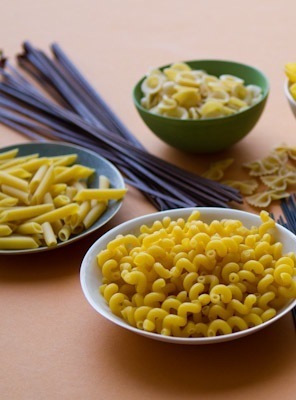
Oodles and oodles of boxed pasta. Photo by Stephanie Stiavetti.
Stephanie Stiavetti (@sstiavetti) writes The Culinary Life blog. Her first book, Melt: The Art of Macaroni and Cheese , will be available October 22 from Little, Brown, and it’s superb, the best one I’ve seen, in fact, accept no imitations!
I’m always game for a rant, especially first thing in Monday morning. Take it away, Steph! —M.R.
You’ve heard Michael’s spiel on Americans being trained to believe they’re too stupid to cook. It’s an unfortunate reality that people in this country place a higher priority on time than they do nearly everything else, which greatly affects what we eat. Which affects our health. Which, in the end, affects EVERYTHING. When you eat poorly, guess what? You feel poorly too. You don’t have the energy to do the things you want to do: hitting the gym, playing ball with the kids, actually getting up to go to a movie instead of streaming Netflix while lolling on the couch. All of those things feel like too much effort.
Hey couples: have you noticed that either (or both?) of your libidos have gone down the tubes? What do you two eat everyday? Might want to look into that. Just sayin’.
A few months ago I ranted about cheese, and today I’m compelled to go off on cheap boxed pasta. To be clear: there’s nothing inherently evil about cheap pasta. If you throw something healthy on top of it—like a freshly made pesto, perhaps—then boxed pastas are leagues ahead of countless other things you could be eating, but if you’re at all interested in spiffing up your diet to include high-quality carbs, then that sub-$1 box of generic elbow macaroni might be a good area to investigate.
What’s the primary issue with cheap boxed pastas? As you might have guessed, it’s made from cheap grain. Large-scale pasta operations produce their wares in huge factories, and these factories need to be fed enormous amounts of wheat to churn out 734,387,632 pounds of noodles a day. Do you know any small-scale farmers who can produce quality grain in that kind of quantity? Probably not.
With only a few exceptions, the wheat used to make industrial-made pasta is generally of mass-produced, hybridized (see my comment below on GMO versus hybrid) stock, before it goes through a dizzying amount of processing to get it down to the gossamer white powder we’re so used to eating. Some experts go so far as to say that a lot of the wheat produced these days is not nearly as healthy for you as heritage varieties, which are locally produced on a much smaller scale.
Then there’s the taste and texture issue. Crappy pasta tastes, well, crappy when compared to higher-quality noodles, due both to the lame wheat used and to the fact that it’s made on industrial equipment that does not produce the proper texture. YES, the surface of pasta is meant to have texture. What do you think the sauce is supposed to cling to? Have you ever tried pouring marinara on the windshield of your car? How much sauce would actually hang out on the surface, versus the amount that ended up in a puddle at the base of your windshield wipers? Exactly. Please, for the love of god, avoid super-smooth noodles that could be buffed to a glassy shine. You’re missing the whole point.
Now, there’s a lot to be said for small-production, artisan-made boxed pasta, which often tip the scales when it comes to flavor, texture, and ingredient quality. Brands like Rustichella d’Abruzzo, Cipriani, and Baia produce some excellent varieties. When cooked correctly they’ll sing at the touch of even the simplest sauce, making for a veritable triumph at your dinner table. To take it up yet another notch, many major supermarkets have started selling fresh pastas in the refrigerated aisle, which will give you an even better experience than artisan-made dry pasta, but at that price point, it’s better to make it yourself.
Wait, what? Make it yourself? You heard me. So many folks believe that making pasta is a huge undertaking meant for only the highbrow culinary elite, but that’s just not true. Homemade pasta is relatively quick to make and it’s insanely cheap. Seriously. All you need is some flour and a couple of eggs. And when made in quantity it freezes beautifully, perfect for those “quick & easy” meals Americans love so much.
So how do you go about making pasta? Well, you’ll have to wait for my next post to find out what I’ve got to say about that.
**When I referred to genetically modified wheat, I was using the term in its literal meaning to indicate that the wheat in our food supply has been highly hybridized to maintain/improve certain traits. So those taking issue with my use of GMO are correct, if adhering to the widely adopted meaning of the term. While our wheat has not experienced a “direct manipulation of its genome using biotechnology,” (please excuse the wikipedia explanation, but it was the most succinct for this addendum) it has indeed undergone changes on a genetic level, via hybridizing, to alter its characteristics. We’re modifying the article so that the wording is more clear in the public understanding.
If you can’t wait for Steph’s post, which will surely be more than a simple recipe, take a look at these links:
My past post on making pasta from scratch.
Make a simple tomato sauce.
Aki & Alex of Ideas in Food share their one minute pasta method.
An interesting recipe for making a one pot pasta and sauce dish.
© 2013 Michael Ruhlman. Photo © 2013 Donna Turner Ruhlman. All rights reserved.
August 16, 2013
Friday Cocktail Hour: Basil Gimlet
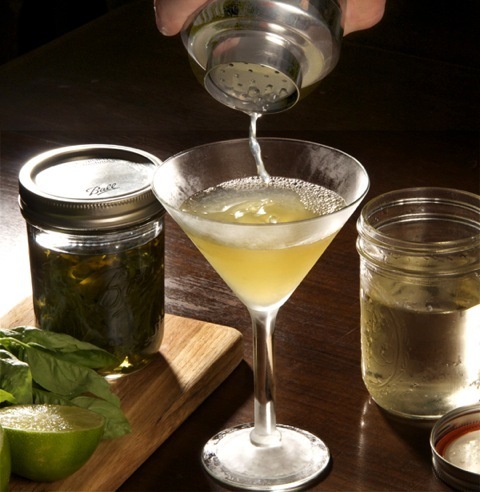
The basil gimlet. Photos by Donna Turner Ruhlman.
I am normally straight at you like a knife, cocktailwise. A martini is gin with vermouth you can taste, and a twist. Period. Either there is no other martini or the name doesn’t mean anything. (I refuse to back down on this one, sorry. I like vodka, I own vodka, I drink vodka, but vodka and vermouth is a stupid drink with an appropriately stupid name.) I want plenty of bitters in my Manhattan. After the martini, there’s no better drink than an old-fashioned.
So you’d think I’d pooh-pooh infusing decent spirits with shit from my herb garden. And I did. Until a new pal made Donna a gimlet with basil-infused gin. And he made a delicious summer cocktail with cantaloupe and basil-infused tequila. Basil is in full growth now, and it takes only a day or two to infuse a spirit with it, so I gave it a whirl, and found I love the summer mood it gives to a drink, the floral savory notes that tell you it’s the middle of August, and that it’s OK to relax a little.
The gimlet is also something of a neglected drink, in large part because for years it has relied on that cloying, lime-flavored sugar-water called Rose’s Lime Juice. Here I’m taking it back to its Imperial roots and simply making it with gin, lime juice, and simple syrup, in effect a gin sour. Truly refreshing on a summer evening.
To infuse any alcohol with any herb, put plenty of herbs in a jar, fill it with the spirit of your choice, and let it infuse for 24 to 48 hours, giving the jar a shake every now and then, or until the spirit tastes as you wish. Strain through cloth.
If you don’t have basil on hand or are drinking along with the Friday cocktail hour, a good gin (Tanqueray is excellent for a gimlet), sans basil, will suffice. If you want to use vodka, go ahead—it works perfectly well here (but there should be a name for it, no?). I prefer the lip-puckering proportions below. Donna thinks it’s too sweet and sour. So feel free to reduce both lime and simple syrup by half or to taste.
Happy summer Friday, all!
Basil Gimlet
2 ounces basil-infused gin (or gin of your choice)
1 ounce lime juice
1 ounce simple syrup
1 disc of lime (for garnish)
Combine the fluids in a shaker and fill it with ice. Stir or swirl gently for 60 to 90 seconds and strain into a chilled martini glass.
Do absolutely nothing other than enjoy your drink and the summer air.
If you liked this post, take a look at these links:
My other cocktails that feature gin: Hasty Negroni, Tom Collins, and French 75.
Still my favorite watering hole: The Velvet Tango Room here in Cleveland.
A few more forgotten gin recipes you can shake up.
The Gin Blog’s perspective and recipe on the gimlet.
© 2013 Michael Ruhlman. Photo © 2013 Donna Turner Ruhlman. All rights reserved.
August 14, 2013
Le Creuset Technique: The Seafood Terrine
We’re back again with another valuable technique, the water bath, essential for gentle cooking. The water bath uses the miracle tool, water. Water makes life as we know it possible. It’s one of the only substances that expands when it freezes rather than contracts (if it didn’t, ice would sink, not simply ruining your gin and tonic, but rendering the gin and tonic moot, as most of habitable earth would be flooded). Water cannot go above 212°F in normal circumstances (it can if you heat it under pressure or, with less pressure, specifically at high altitudes, it turns to gas at lower temperatures). And importantly, it cools as it evaporates (which is why sweating cools our body).
In this video we use it to gently cook emulsified shrimp and cream, mixed with whole chunks of seafood for an easy and elegant crab and scallop terrine. (A water bath also creates a super-juicy meatloaf, btw.)
You can read more about terrines in my book Charcuterie, if you’re so inclined, and I rhapsodize about water as one of the key techniques in Ruhlman’s Twenty. I’ll be back next week with another technique. See more of my technique videos here on the LC site. Also, at the end of the video, there’s a fun experiment LC is trying, called the Pass It On Potluck. I’m fascinated to see how it’s going to work. To enter, go here.
Seafood Terrine
1 cup heavy cream
½ teaspoon saffron
16 ounces peeled and deveined shrimp
2 egg whites
1 teaspoon salt
1 leek, white part only, thoroughly cleaned, diced small and sautéed in butter till tender, then chilled
6 ounces/120 grams scallops, chopped in large chunks or whole if small
6 ounces/120 grams lump crab meat
¼ cup minced chives
Bring the cream to a simmer over high heat, then remove from the heat and add the saffron. Let the saffron infuse the cream for 15 to 20 minutes. Strain into a clean container and thoroughly chill.
Preheat your oven to 300°F/149°C.
Be sure all ingredients to be pureed are very cold. Puree the shrimp with the egg whites and salt in a food processor. With the machine running, slowly add half of the cream. The mixture should be stiff enough to shape. Continue adding the rest of the cream with the machine running.
In a mixing bowl combine the shrimp mousseline with the leeks, scallops, crab, and chives, gently folding the garnish to distribute it evenly.
Line a terrine mold with plastic wrap (it helps to wet the mold so that the wrap sticks). Fill the terrine mold with the seafood. Fold the plastic wrap over it and cover with a lid (or foil).
Bring a large pot of water to a simmer. Set the terrine in a roasting pan and pour the simmering water into the roasting pan so that it comes three-quarters of the way up the sides of the terrine mold. Put the roasting pan in the oven and cook until the terrine reaches an interior temperature of 135° to 140°F/57° to 60°C. Watch the video for serving ideas.
Makes eight 3-ounce portions.
Mayonnaise
1 tablespoon shallot, minced
1 tablespoon plus 2 teaspoons fresh lemon juice
1/2 teaspoon salt
1 teaspoon water
1 egg yolk
Pinch of cayenne powder
¾ cup/180 milliliters vegetable oil
Combine the shallot with 1 tablespoon of the lemon juice and set aside while you make the mayonnaise.
Combine the remaining 2 teaspoons lemon juice, the salt, water, yolk, and cayenne in a bowl (or in a large Pyrex measuring cup if you’re going to use a hand blender, my preferred method). Whisking continuously, add a drop or two of the oil into the bowl or cup to establish the emulsion, then continue pouring the oil in a thin stream into the bowl while whisking, until all the oil has been incorporated and the mayonnaise is thick and sumptuous. If using the hand-blender method, you can add the shallot after mixing for a chunkier mayo, or blend the shallot with the yolk for a smooth finished mayo.
Makes about 6 ounces/180 grams
If you liked this post, take a look at these links:
My recent Le Creuset post on the mini cocotte: baked eggs.
Check out my dear friend and colleague Chef Brian Polcyn’s restaurant Forest Grill in Birmingham, Michigan.
A great little article on making terrines that ran in the NYT several years ago.
Learn more about sustainable seafood at the Nature Conservancy.
© 2013 Michael Ruhlman. Photo © 2013 Donna Turner Ruhlman. All rights reserved.
August 13, 2013
The Book of Schmaltz, Available Today
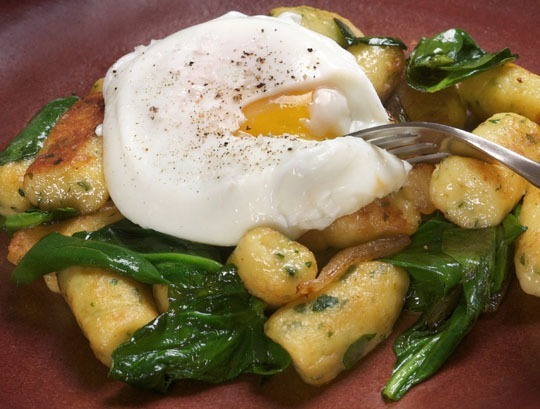
A classic french preparation, Parisienne gnocchi (with spinach and poached egg), transformed by schmaltz. Photo by Donna Turner Ruhlman.
The Book of Schmaltz: A Love Song To a Forgotten Fat is available today. And while I love the impact of schmaltz on classic Jewish dishes such at kreplach and helzel, I also love the new uses I’ve found for the much maligned fat. These Parisienne gnocchi, for instance, pate a choux made with schmaltz instead of butter, boiled, then sautéed in schmaltz. Here’s a post on pate a choux, or use the ratio to make as much or as little as you want.
Schmaltz, rendered chicken fat flavored with onion, is one of the great flavors and fats to use in cooking. It’s too good to be relegated to Jewish cuisine alone, though, I have to admit, there’s not a lot that can beat pure schmaltz spread on warm rye toast.
L’chiam!
August 12, 2013
Schmaltz: The Hardcover Comes Out Tomorrow!

The Book of Schmaltz.
When Donna and I published The Book of Schmaltz as an app for iPads, I never expected it to be published as a book book. (Yes, even though it’s called “The Book of.”)
And yet, I always knew that would be its most valuable form. The book’s muse, for instance, my neighbor Lois Baron, had never even held an iPad, and she’s the ideal customer. And I’m lucky my editor at Little, Brown thought publishing an actual book was a good idea, too. Tomorrow, The Book of Schmaltz is officially released as a book book.
David Leite wrote this about the app when it came out.
Max Gross wrote about the book in this weekend’s New York Post. (Though I must take issue with the use of “grease” in the headline. Schmaltz is a fat and is delicious to cook with and to eat. Grease is something that floats in the air and gums up kitchen surfaces. Grease is bad. That’s why restaurants have grease traps.)
Fat is good, and schmaltz—chicken fat rendered with onion—is one of the best fats you can use.
The Book of Schmaltz is truly a love song to a forgotten fat, as the subtitle says.
Pre-order it any of the following sites:
If you liked this post, take a look at these links:
My recent post: Q & A with Forrest Pritchard.
The other books I have written.
A few of my recipes from The Book of Schmaltz that appeared on Epicurious.com.
Don’t forget about my upcoming events this fall.
© 2013 Michael Ruhlman. Photo © 2013 Donna Turner Ruhlman. All rights reserved.
August 9, 2013
Friday Cocktail Hour: The Ludwig

The Ludwig, a great summer cocktail. Photo by Tobin Ludwig. Hand model, Tobin Ludwig.
We’ve taken up part-time residence in Manhattan and discovered that our downstairs neighbor is Tobin Ludwig, one of the partners in Hella Bitters. We were having cocktails in his apartment when he passed around some exquisite cantaloupe. In season, it was juicy and sweet; chewing, Tobin said, “This would go great in a cocktail.”
And the challenge was on. He would follow the local and seasonal in creating an elegant summer cocktail using cantaloupe and the basil that is in full flourish, infusing reposado tequila, made from the highly vegetal cactus plant, with this herbaceous leaf.
“Basil is a great cocktail ingredient,” Tobin says, “because it’s so versatile. It can go savory or sweet.”
To infuse spirits with herbs, combine torn leaves with the spirit of your choice for 48 hours and strain. For basil tequila, Tobin says to start with Espolón or other affordable reposado. Add about one torn basil leaf per ounce. Combine in a Mason jar and shake once before you go to bed and once again when you wake, then repeat the next day. Taste until you get the desired flavor—the aged tequila and the basil make for a unique, funky, herbaceous and slightly savory base spirit.
To make cantaloupe juice, simply puree fresh cantaloupe in a blender and strain through cloth or a fine-mesh strainer.
The final ingredient is Barenjager, a honey liqueur made by Jagermeister, but you can use honey cut with an equal part water.
Serve in a coupe and garnish with lime. A truly seasonal and refreshing cocktail.
The Ludwig
1.5 ounces basil-infused reposado tequila
0.75 ounce cantaloupe juice
0.5 ounce Barenjager (or 1/2 tablespoon honey mixed with 1/2 tablespoon water)
0.5 ounce lime juice
Thin lime circle, for garnish
Combine all of the ingredients in a cocktail shaker.
Add ice and shake or stir.
Strain into a chilled coupe glass and garnish with lime.
If you liked this post, take a look at these links:
My past cocktail posts featuring tequila: the Paloma, the Margarita, and El Diablo, and one on sipping tequila.
Learn how to make your own honey liqueur.
Become a member of the Tequila Interchange Project.
Infuse your own tequila by using these flavor combinations.
© 2013 Michael Ruhlman. Photo © 2013 Donna Turner Ruhlman. All rights reserved.
Michael Ruhlman's Blog
- Michael Ruhlman's profile
- 354 followers


